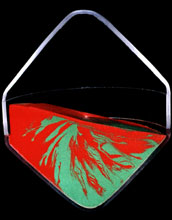Multimedia Gallery
Chaotic Mixing in Double-Cone Blender
Chaotic Mixing in Double-Cone Blender
This image shows the mixing pattern that results from tumbling identical red and green grains in a common design of tumbling blender used by catalysis, pharmaceutical, food and other processing industries. The blend is initially placed with red on the left half and green on the right, and is tumbled one revolution clockwise in this view; the grains are then frozen by infiltrating with polymer, and the tumbler is sliced open to expose the intricate fractal mixing pattern that is a signature of chaotic mixing. In this system, chaos results from nearly periodic stickslip motion at the surface of the tumbling bed.
This work was performed at the Center for Structured Organic Composites (C-SOC), a National Science Foundation Engineering Research Center (ERC) based at Rutgers University. The center was established to study the nature of finely ground granular materials and other substances that form the core of drug tablets, processed foods, agricultural chemicals and other "composite organic" products. In addition to improving the quality and consistency of such materials, the center will develop more consistent and cost-effective manufacturing techniques than methods based largely on trial and error.
To learn more about work at this center, visit the C-SOC Web site. Further information about the NSF Engineering Research Centers program, including a list of the centers currently funded and links to their Web sites, is available at http://www.nsf.gov/funding/pgm_summ.jsp?pims_id=5502. (Date of Image: unknown) [One of several related images. See Next Image.]
Credit: A.W. Alexander, F.J. Muzzio, T. Shinbrot; Rutgers University, Center for Structured Organic Composites
Images and other media in the National Science Foundation Multimedia Gallery are available for use in print and electronic material by NSF employees, members of the media, university staff, teachers and the general public. All media in the gallery are intended for personal, educational and nonprofit/non-commercial use only.
Images credited to the National Science Foundation, a federal agency, are in the public domain. The images were created by employees of the United States Government as part of their official duties or prepared by contractors as "works for hire" for NSF. You may freely use NSF-credited images and, at your discretion, credit NSF with a "Courtesy: National Science Foundation" notation.
Additional information about general usage can be found in Conditions.
Also Available:
Download the high-resolution JPG version of the image. (945 KB)
Use your mouse to right-click (Mac users may need to Ctrl-click) the link above and choose the option that will save the file or target to your computer.



